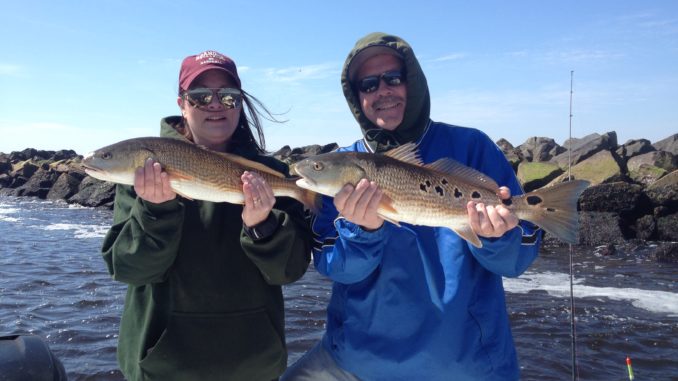
Outside edges of jetty rocks will hold plenty of reds if you can pinpoint them.
After a long winter, fishermen can find a strong fishery cranking into high gear as the spring thaw approaches. For light-tackle anglers familiar with the rock jetties that straddle the North Carolina-South Carolina state line can expect a fantastic redfish bite along the rocky fringes of Little River Inlet.
Since 1984, rock jetties have protected Little River Inlet from excessive silting and allowing safe passage through the inlet, but their collateral effect on fishing has been immense. The massive chunks of granite have created more than 14,000 feet of fish habitat that is nothing less than a fish haven. From flounder, sheepshead and speckled trout to black sea bass, black drum, sharks and redfish, the jetties are well-used by many different species throughout the year, including the early spring months.
During the early spring, Mark Stacy of Ocean Isle Fishing Charters regularly takes his clients to the jetties for a redfish rodeo. For Stacy, the jetties attract redfish for one simple reason.
“The jetties hold bait most of the year. Even during the coldest months, there will always be some bait around the rocks.” he said. “The jetties will always have some redfish throughout the year and around entire tide cycle.”
Ocean temperatures range from the high 40s to the mid 50s during March. Small schools of bait will hold up along the heavy structure at various water depths. They typically split into two groups, with one population taking refuge in the shallow, headwater creeks in the middle of the marsh and the other venturing out to the oceanfront and the jetties. And both of these habitats provide places to hide from marine mammals and to get something to eat.
However, neither the bait nor the redfish will be super concentrated in one particular place. The bait moves from the shallow rocks to the deepest places near the jetty tips, depending on the changes in conditions and water temperatures.
While water temperatures will remain somewhat stable in the ocean, an early season heat-up will elevate the shallow inshore waters as much as 5 to 7 degrees. And this slug of warm water will pass right by the jetties, offering a unique situation for hunkered-down marine creatures. Warm water attracts bait, even if it is just a short period during a tide cycle. As a result, the redfish may not always hold in the same positions each day.
“The fish will not hold tight to one specific rock or specific side. You have to move around and find them,” said Stacy, who typically fishes the low tide on the ocean side of the rocks first but will fish the inside as well.
“I like to fish the outside on the low, rising tide and the inside of the jetties on the falling tide,” he said.
Fish hold tight to the rocks, but the edge of the rocks may not be just what is visible above the water’s edge.
“The rocks will fan out. I fish anywhere from the edge of the exposed rocks to 30 feet away,” said Stacy, who fill often fish a float rig with an adjustable bobber stopper so he can get his baits close to the rocks at the right depths.
“Try to get bait just off the bottom,” he said. “I will place the baits 3 or 4 feet below the cork, usually, and sometimes I will fish significantly deeper than that.”
The water is naturally clearer during the winter, especially on the ocean side of the rocks. Redfish are not known for their eyesight, but clear water will help improve the bite any time it’s present.
Live shrimp or minnows are solid bait choices. Stacy will also use artificial lures, such as Jumbo Vudu Shrimp and any of the Gulp! baits, either attached to the end of the float rig or free cast, but he can’t stress enough that keeping your bait or lure as close as possible to the rocks if of paramount importance.
“If you aren’t hanging in the rocks some, you are not fishing in the right spot,” says Stacy.
While small schools of reds can play hide and seek at the jetties under early spring conditions, Mark Dickson of Shallow Minded Inshore Guide Service in Little River eliminates the guesswork and anchors his boat in one of two places.
“If you sit at the end of the rocks and dead-stick bait in that 30-foot hole, you can catch some really nice reds,” said Dickson. “Both jetties have deep holes right at the ends.”
The water temperature in these deepwater refuges remains constant and is usually slightly warmer than the surface, and that helps them hold fish. Dickson will anchor where he can cast baits both up against the rocks and into the deep holes. While he prefers to fish falling water towards the end of the tide, high water is okay at the ends of the jetties.
With only a select amount of food around, these redfish are not selective about what they eat. Dickson will use cut mullet, shrimp or any kind of frozen fish.
“Anchor up, toss baits into the deep hole and they will bite it,” he said.
Since the currents are typically stronger at the tips of the jetties, Dickson will use heavy duty terminal tackle with at least 2 or 3 ounces of weight on his Carolina rig and a super-strong 5180 Owner circle hook.
“(You) need to beef it up to keep it on the bottom at the end of the jetties,”he said.
DESTINATION INFORMATION
HOW TO GET THERE — The Little River jetties can be easily access from the two public boat ramps under the US 17 bridge over the Intracoastal Waterway in North Myrtle Beach or the public boat ramp at Ocean Isle Beach. The entire margin of each jetty can produce fish during the early spring. Redfish will move to either side and into different depths. When the water is cold, the outer third of the jetties and the deep holes at the end of the jetties are the best. When the water warms, the shallower sections will attract baitfish and reds. Outside of the rocks tends to be the best on low water, and the inside is usually the best on higher water.
WHEN TO GO — Redfish can be found around the jetties almost year-round, but late winter and early spring are the best times to find fish is during periods of stable and warmer weather. The best time to fish is on lower water between the last two hours of the falling tide to the first two hours of the rising tide, but it is possible to catch redfish on any tide cycle at the jetties.
BEST TECHNIQUES — Live mullet, mud minnows and shrimp are preferred baits, but reds will eat chunks of dead bait if presented correctly. Fish baits close to the rocks on float rigs or Carolina rigs with 2- to 4-ounce egg sinkers and 1/0 to 2/0 circle hooks. A short leader of 6 to 8 inches of 20-pound mono is preferred for Carolina rigs. which are fished vertically in the structure. Artificial lures can produce good results; Gulp! baits of various colors and sizes and the Jumbo Vudu Shrimp are good options fished along the bottom in and out of the rocky structure.
FISHING INFO/GUIDES — Mark Stacy, Ocean Isle Fishing Charters, 910-297-0119, www.oceanislefishingchartrs.com; Mark Dickson, Shallow Minded Inshore Guide Service, 843-458-3055, www.fishmyrtlebeach.com. See also Guides & Charters in Classifieds.
ACCOMMODATIONS — Hampton Inn, North Myrtle Beach, 843-249-1997; Sleep Inn, Little River, 843-249-4848; Myrtle Beach Area Convention and Visitors Bureau, www.mbchamber.com; North Carolina Department of Travel and Tourism, www.visitnc.com.
MAPS — Navionics, 800-848-5896, www.navionics.com, 800-848-5896; Waterproof Charts (Near shore #98), 800-423-9026, www.waterproofcharts.com, Maps Unique, 910-458-9923, www.mapsunique.com; SeaLake Fishing Guides, 800-411-0185, www.sealakeusa.com.

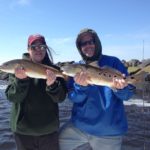
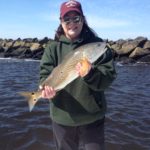
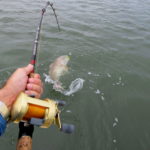
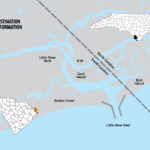




Be the first to comment